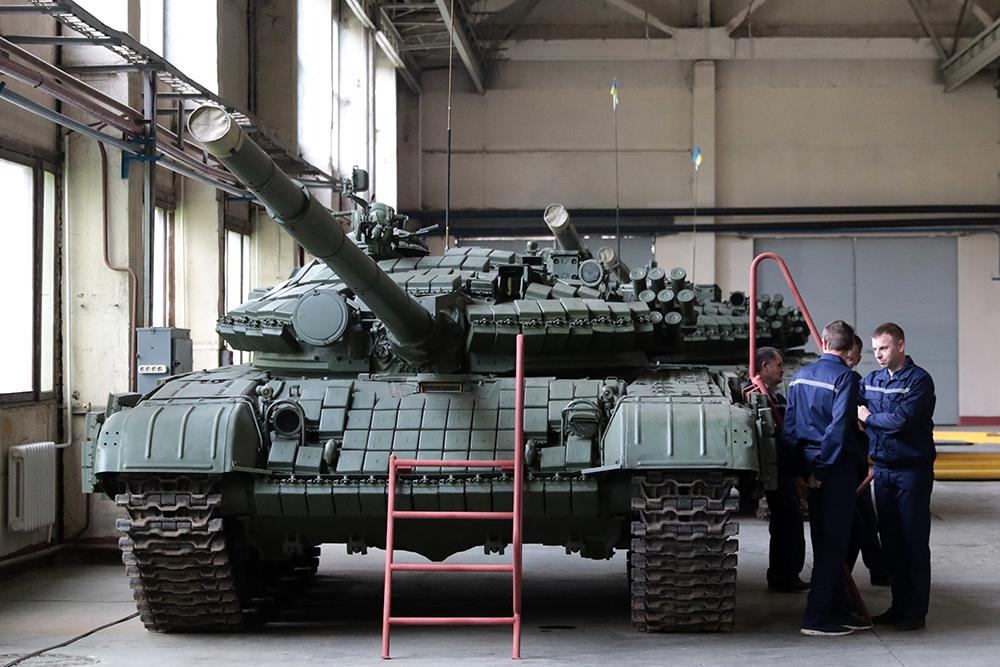During the Russian-Ukrainian war, a practice of using reactive armor for combat vehicles reached an unprecedented scope among tankers. In attempts to protect themselves and their combat vehicles, the servicemen installed ERA blocks on the most unexpected samples of equipment.
However, what do we know about their varieties and effectiveness? Today we will try to overview the common ERA samples and analyze their use.
Kontakt-1 (4S20)
Kontakt-1 is one of the most common explosive reactive armor, installed on thousands of combat vehicles on both sides of the line of engagement.
Kontakt ERA belongs to the first generation and was developed in 1982 by the Soviet Scientific Research Institute of Steel in order to increase the protection of armored vehicles from HEAT rounds and missiles. In the armed forces, its elements are known under the 4S20 index.
4С20 ERA is a plate, which in the section resembles a “sandwich” made of explosives, being covered with metal plates with a thickness of 2.3 mm on both sides. The layer of PV-5A explosives itself (85% hexogen) is 5.4 mm thick and weighs 260 grams.
The principle of action of Kontakt-1 is based on scattering of the shaped charge by throwing a metal plate in its direction under the action of the energy of the directed explosion.
When the explosive reactive armor (ERA) is penetrated with a shaped charge, the explosive in it detonates and “pushes” the body plates to opposite sides. During the movement, the plates cross the trajectory of the shaped charges, constantly affecting it. Part of the shaped charges is applied to break through these plates, and the lateral impulse from the collision destabilizes it.
Provided that the elements of ERA are installed on the armor properly, it is able to level up to 350-400 mm of armor penetration of the shaped charges. On APFSDS projectiles Kontakt-1 ERA has no impact.
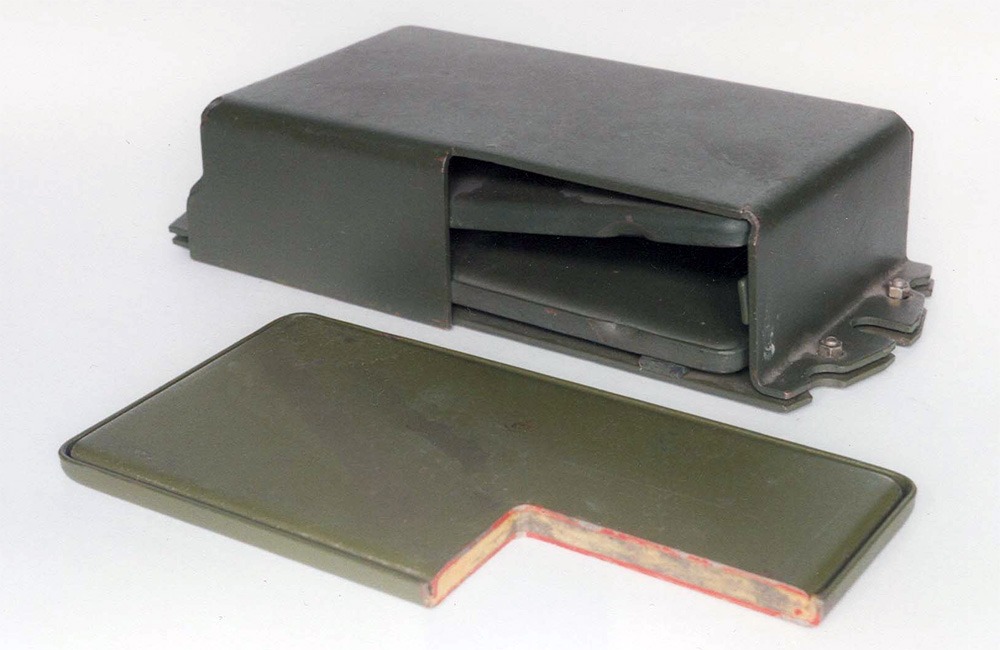
Installation of ERA plates in containers is done in two layers at an acute angle (50-70 degrees) relative to a possible vector of enemy ammunition hit. This is necessary due to the fact that the efficiency of impact on the shaped charges depends on the angle of contact of the shaped charge with the metal plate. When HEAT ammunition hits the ERA at an angle close to 90 degrees, most of the countermeasure effect is lost.
That is why on all Soviet tanks (except Т-72B) ERA blocks are installed at an acute angle. This can be traced on the example below of Т-72 tanks modernized by Ukraine.
On the sides of the vehicles, the containers are installed at a right angle relative to the side, but this is done due to the possible hit of ammunition on the side from the front projection at an acute angle.

According to the experience of use in numerous armed conflicts and wars, Kontakt ERA demonstrated its effectiveness against old non-tandem HEAT ammunition and most hand-held anti-tank grenade launchers with armor penetration in a range of 500 mm.
Reactive armor, if it does not completely neutralize the shaped charges, then greatly weakens it, allowing it to finally stop the main armor.
One of the disadvantages of explosive reactive armor is, in fact, explosive energy, which can destroy weak structures, as in the example below.
Thus, during the battle, after hitting a rather weak warhead of the Lancet loitering munition in the Kontakt-1 module, a track shoulder was torn by an explosion, smoke grenade mortars were destroyed and part of the fasteners were torn off.
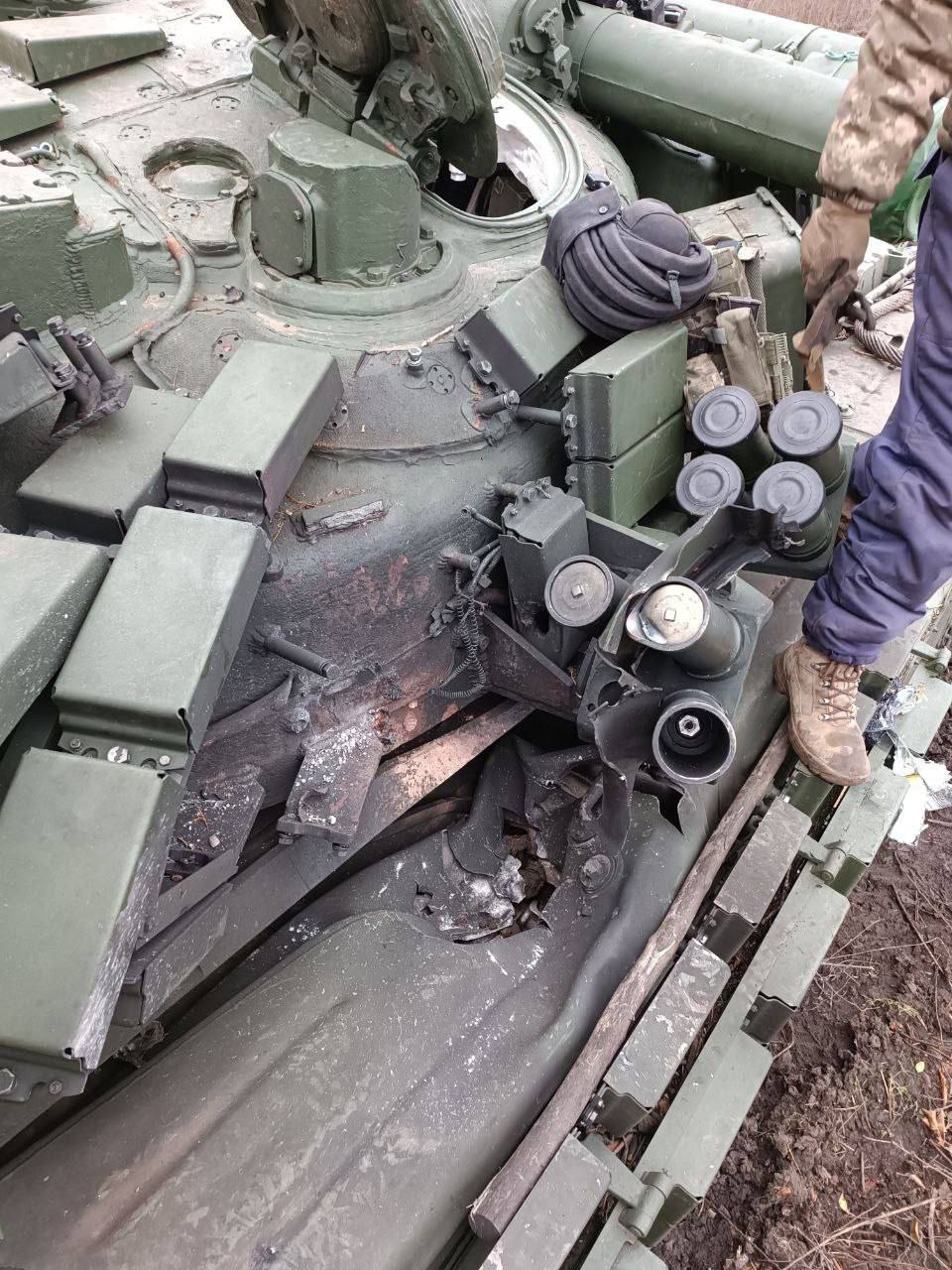
Due to their high destructive properties, it is impossible to install it on lightly armored vehicles with thin armor. Known cases of such manipulations led to the breakdown of the armor by explosion, followed by damage to the components of the vehicle and crew with secondary debris.
It is also worth noting that due to the energy of the explosion when one element is activated, a chain reaction of initiating neighboring blocks begins, which often leads to an exposure of large areas of armor from one hit and, potentially, significant damage to the external organs of the vehicle by detonation energy.
The approximate weight of the Kontakt-1 ERA for tanks of the Т-64/Т-72/Т-80 series amounts to 1.5-2 tons.
Kontakt-5 (4S22)
A further development of the Soviet Kontakt-1 with the throwing of armor plates was the creation in 1986 of the first serial model of ERA of the second generation known as Kontakt-5. It acquired the ability to counteract APFSDS ammunition.
The acquisition of new capabilities was achieved by using more powerful PVV-12М explosives in elements of reactive armor, as well as their installation in the containers built into tanks armor.

New containers (Т-72B3, Т-80U tanks etc.) received heavy 16 mm armor plates. Approximate protection of the new ERA when initiated at the correct angle reaches about 450 mm against shaped charge.
The built-in reactive armor received a significant advantage even in the essential isolation of the ERA blocks from each other due to which the effect of the chain reaction was leveled, as in the previous Kontakt-1.

A significant disadvantage of such a scheme of use is the inability to quickly repair and replace detonated units of reactive armour in the field. The only way out is to send the tank to the maintenance battalion or even to the tank repair plant. This greatly undermines logistics in quite inconsequential damage.
Also, this arrangement of ERA elements leaves significant gaps with unprotected zones in which the ammunition can hit and penetrate the main armor bypassing the ERA. Similar cases were recorded, as written below.
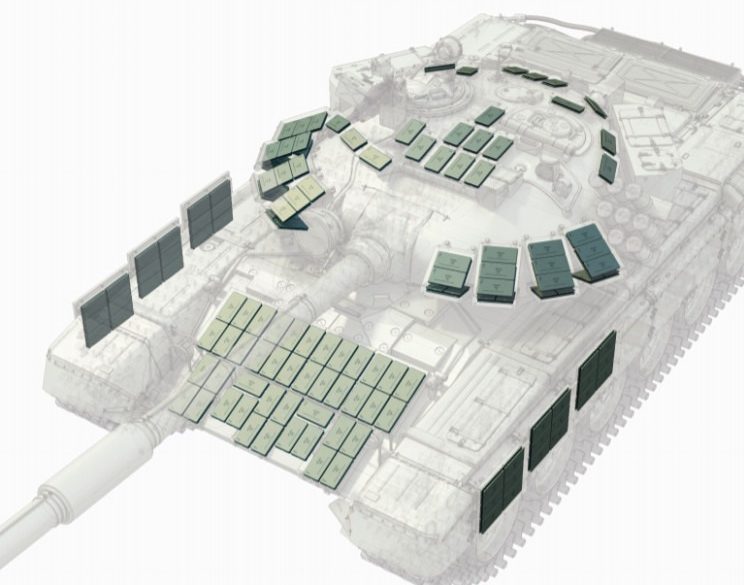
In the course of hostilities, it became known that the Kontakt-5 was somewhat more effective than its predecessor in countering non-tandem HEAT ammunition while remaining the same ineffective against ammunition with a tandem warhead.

According to official information, Kontakt-5 is able to neutralize up to 20% of the penetration capacity of kinetic weapons such as APFSDS ammunition.
The approximate weight of the Kontakt-5 ERA for tanks of the Т-72/Т-80 series is about 2-2.5 tons.
Nizh (KhSChKV-34)
Following the collapse of the Soviet Union, independent Ukraine continued to develop its own branch of the armored industry, including its institutions, which were engaged in the development of reactive armor.
As a result, the Microtek state enterprise of the first serial Nizh (Knife – ed.) ERA was developed, the concept of which was based on the use of shaped charges.
In addition to Kontakt ERA, the Ukrainian development was created on the basis of the principle of operation of many shaped charges, which, when initiated, damaged the attacking ammunition. Due to this, reactive amour is able to counteract both HEAT and kinetic ammunition.

In the Nizh elements, the charges are placed in close proximity to each other, thereby creating a detonation circuit and ensuring the transfer of detonation to neighboring charges. During the explosion, numerous flat shaped charges are formed cutting the object above them.

Under the action of these “knives,” either the shaped charge is completely dispersed or the rod of the APFSDS ammunition is destroyed, with the latter failing to penetrate the armor and being destroyed itself after the damage caused by the energy of the impact on the armor.
The dents from shaped charges, similar to a number of consecutive shallow grooves as from wheels on the ground, often remain as signs of successful actions of this reactive armor.

Currently, it is difficult to find confirmation of a hit in the Nizh ERA of APFSDS ammunition in real combat in order to confirm or refute the declared characteristics.
Nevertheless, in the course of numerical laboratory tests, the manufacturer’s claimed ability to completely stop or seriously prevent the penetration of kinetic ammunition was confirmed. The photo below shows the consequences of hitting the 125mm APFSDS in the exposed cutout of the frontal tank armor (on the right) and in the area covered by the Nizh ERA (on the left).

Along with a shallow burial, one can notice characteristic traces of sequential actuation of numerical shaped charges of reactive armour.
It should be noted that the modules of the built-in Nizh ERA on the frontal part of tanks (on tanks Т-64BM Bulat, Т-84 Oplot is quick-detachable and can be easily replaced by a maintenance personnel in a short time).
The weight of the Nizh ERA for Т-64БМ tanks is a record in its class, being 4 tons. Nevertheless, the set of adapted elements of the Kontakt ERA hinged containers weighs less.
Relikt (4S23)
The feather development of the family of Soviet Kontakt ERA was the appearance in 2006 of the Russian Relikt ERA.
One of the reasons for the development of a new type of reactive armor was the emergence of new 120mm kinetic ammunition for Western tanks (for example, American M829A2), which could penetrate the Kontakt-5 ERA without its initiation and, accordingly, avoiding opposition.

Due to the use of new sensitive explosives in ERA, Relikt began to reliably work with modern samples of kinetic ammunition.
The new more powerful explosive also made it possible to raise the efficiency of counteracting HEAT ammunition.
The design of the Relikt ERA involves the explosion of two heavy metal plates in opposite directions, which also allows it to provide some protection against tandem HEAT ammunition.
Inside the containers there are 4S23 Relikt elements installed in two layers, with one on top of the other, as in the photo below.

The use of a complex volumetric design with several layers of ERA and two thick bouncing plates in special sections made the modules of the built-in ERA dimensional, which can be traced in the image of a destroyed Т-80BVM tank. It is worth noting that the new modules have become quick-detachable and can be replaced in the field when disabled.

An increase in the charge of explosives and its power in the elements of the Relikt led to a serious risk of breaking through the thin armour of the tank turret roof on which protection was installed.
To compensate for the explosion energy, the designers of the Russian Scientific Research Institute of Steel installed special tubular dampers filled with polyurethane between the ERA units and the turret. They should absorb some of the energy moving in the direction of the armor.

It is also worth paying attention to an interesting innovation in Relikt kits in the form of volumetric containers on the sides of the turret. They are specially designed to solve one of the main disadvantages of reactive armour – minimal efficiency in counteracting right-angle hits.
In the middle of the containers with thin metal walls there are familiar elements of the 4S23 ERA at an angle relative to the potential direction of incoming projectiles. In one container there are 4 layers of ERA covered with a damper for insulation.

The example below shows the case of successful actuation of these modules, which, obviously, completely neutralized the hit of the HEAT ammunition. According to the Russians, the blow was carried out by an NLAW ATGM in direct hit mode.

The approximate weight of the Relict reactive armour kit for Т-72/Т-80 tanks is 2.5 tons.
Problems and Benefits of ERA
One of the main advantages of using reactive armour is the sharp suspension of armor protection relative to the added mass. In terms of dry digits, ERA is many times more effective than conventional passive armor in the protection/mass ratio, although it cannot completely replace it.
Thanks to ERA kits, such as the Kontakt-1 in the Russian-Ukrainian war, hundreds of old Soviet-era tanks and even some of Western armored vehicles, such as the German Leopard 2A4, were modernized by both sides in the field.
However, explosive reactive armour has a number of serious disadvantages. In comparison to the passive protection, ERA is essentially a disposable element, so the repeated hit of the ammunition in the previously affected area of the armor will encounter weakened resistance and, presumably, will penetrate the armor.
Also, a significant drawback of the ERA was the fragmentary installation of its elements on the armor, which led to the appearance of unprotected areas between them.
The photo below shows the episode of such a defeat of the Russian Т-80BVM tank: the kinetic munition hit the upper frontal part, passed between the elements of the Relikt ERA without hitting them, penetrated the main armor, the place of the driver, and hit the rounds rack followed by its detonation.
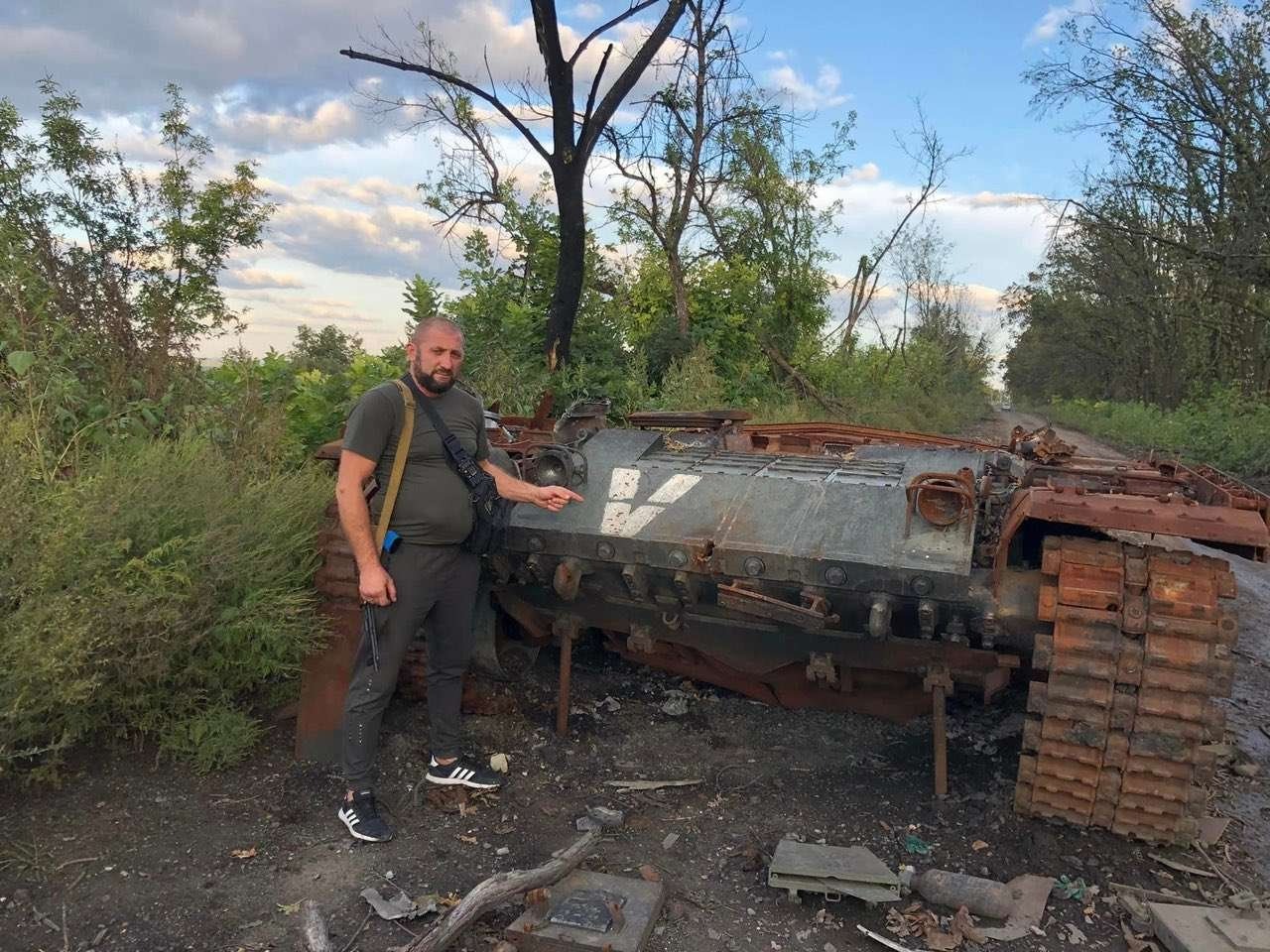
The last, but not least, fact remains that ERA, despite all its characteristics, is essentially a large accumulation of explosives. Its detonation can cause more damage to the fighting vehicle and its equipment than the enemy ammunition.
SUPPORT MILITARNYI
Even a single donation or a $1 subscription will help us contnue working and developing. Fund independent military media and have access to credible information.


 Роман Приходько
Роман Приходько 
 Віктор Шолудько
Віктор Шолудько 
 Андрій Харук
Андрій Харук 

 Андрій Тарасенко
Андрій Тарасенко 
 Yann
Yann 
 СПЖ "Водограй"
СПЖ "Водограй" 

 ГО "Військова школа "Боривітер"
ГО "Військова школа "Боривітер" 

 Катерина Шимкевич
Катерина Шимкевич 
 Олександр Солонько
Олександр Солонько 
 Андрій Риженко
Андрій Риженко 